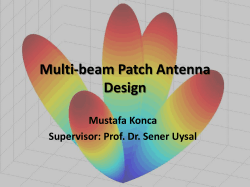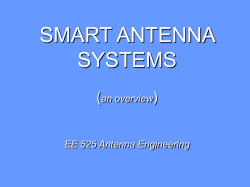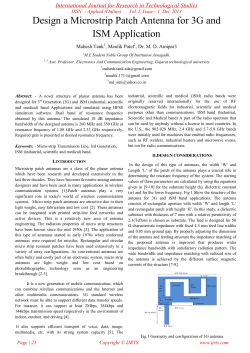
International Journal of Advanced Research in Electronics and Communication Engineering... Volume 3, Issue 11, November 2014
International Journal of Advanced Research in Electronics and Communication Engineering (IJARECE) Volume 3, Issue 11, November 2014 An Overview of Spatial Modulated Space Time Block Codes Sarita Boolchandani Kapil Sahu Brijesh Kumar Asst. Prof. Assoc. Prof Asst. Prof. Vivekananda Institute Of Technology-East, Jaipur Abstract: The major concern of Space Time Code (STC) scheme (which include space-time block codes (STBC), space-time trellis codes (STTC)) is the exploitation of multipath effects in order to achieve high spectral efficiencies and performance gains. Spatial modulation (SM) is a low complexity modulation scheme which is recently proposed for multiple antenna wireless systems. SM is unable to achieve transmit diversity but it provides multiplexing gain by averting inter channel interference with respect to single antenna system. A new modulation concept which combine high multiplexing gain of SM and transmit diversity gain provided by Space Time Block Codes (STBCs) to take advantages of merits of both while avoiding their demerits is referred to as “Spatially–Modulated STBCs” (SM–STBCs). In this scheme the transmitted information symbol are expanded not only to space and time domain but also to spatial (antenna) domain and therefore both core STBC and antenna indices carry information. A low-complexity maximum likelihood (ML) decoder is described for the new scheme which profits from the orthogonally of the core STBC. Keywords: Multiple Input Multiple Output (MIMO), Space Time Block Codes (STBC), Spatial Modulation (SM), SM-STBC INTRODUCTION Multiple-Input Multiple-Output (MIMO) technology [1][2] can be expected as a keystone of many wireless communication systems due to the potential increase in data rate and performance of wireless links offered by transmit diversity and MIMO technology. All upcoming 4G systems will also employ MIMO technology. A space time code (STC) is a method employed to improve the reliability of data transmission in wireless communication systems using multiple transmit antennas. STCs rely on transmitting multiple, redundant copies of a data stream to the receiver in the hope that at least some of them may ISSN: 2278 – 909X survive the physical path between transmission and reception in a good enough state to allow reliable decoding. Spatial Modulation (SM) introduced by Mesleh, is a new advanced low complexity method which uses spatial domain as an additional domain along with space and time domain to transmit information [7][11]. Consequently, SM became a high spectral efficient transmission technology with an equivalent code rate greater than one [12]. It is concerned with exploiting the multiplexing gain of multiple transmit antennas, but the potential for transmit diversity of MIMO systems is not exploited by this system. This leads to the introduction of Spatially Modulated Space Time Block Code (SM-STBC), designed to take advantage of both SM and STBC while avoiding there disadvantages. In this paper basic study of STBC is done. In Section 2, a review of the MIMO is presented. A brief description of Space Time Block Codes & Alamouti Codes is given in section 3 & 4. In Section 5 Spatial Modulation and in section 6 Spatially Modulated Space time block code is defined. Finally, Section 7 includes the conclusions of the paper. Notation: Bold small and capital letters are used for column vectors and matrices, respectively. (.)∗ and (.)H denotes complex conjugation and Hermitian transpose respectively. MULTIPLE INPUT MULTIPLE OUTPUT MIMO (Multiple Inputs, Multiple Outputs) is an antenna technology for wireless communications in which multiple antennas are used and combined at both the source (transmitter) and the destination (receiver) to minimize errors and optimize data speed. The other forms of smart antenna technology are MISO (multiple input, single output) and SIMO (Single Input, Multiple Output). MIMO technology has gained much preference in wireless communication because it provides high data All Rights Reserved © 2014 IJARECE 1563 International Journal of Advanced Research in Electronics and Communication Engineering (IJARECE) Volume 3, Issue 11, November 2014 output and range without additional bandwidth. But the problem is extra transmit power is required since multiple transmit antennas are used instead of only one as in SISO systems. MIMO achieves this by higher spectral efficiency (more bits per second per hertz of bandwidth) and link reliability or diversity (reduced fading). MIMO forms an important part of modern wireless communication standards like IEEE 802.11n (Wi-Fi), 4G, 3GPP Long Term Evolution, WiMAX and HSPA+ because of all above mentioned properties. antennas and p represents the number of time periods needed to transmit one block of coded symbols. The ratio between the number of symbols that space-time block encoder takes as its input (k) and the number of space-time coded symbols transmitted from each antenna defines the rate of a space-time block code. The rate of any space-time block codes with two transmit antennas is equal to one. The rate of a space-time block code can be calculated by: (1) Although the transmission sides are the same, the receiver sides are quite different. The receiver in this case has two receive antennas instead of one, which increases the receive diversity compared with a system with one receive antenna. Fig.1 MIMO Technology SPACE TIME BLOCK CODES Space-time block code was designed to achieve the maximum diversity order for the given number of transmit and receive antennas focus to the restriction of having a simple decoding algorithm. Also, space-time block coding provides full diversity advantage but is not optimized for coding gain. Space-time block codes (STBC) are a generalized version of Alamouti scheme. These codes have the same key features. That is, they are orthogonal and can achieve full transmit diversity specified by the number of transmit antennas. In other words, space-time block codes are a complex version of Alamouti space-time code, where the encoding and decoding schemes are the same as in both the transmitter and receiver sides. The data are constructed as a matrix which has its rows equal to the number of the transmit antennas and its columns equal to the number of the time slots required to transmit the data. At the receiver side, when signals are received, they are first combined and then sent to the maximum likelihood detector where the decision rules are applied. Figure 2 shows space-time block encoder for two transmits and one receive antenna which is the same as Alamouti encoder. As known, space-time block code is defined by nT x p transmission matrix S, where nT represents the number of transmit ISSN: 2278 – 909X Fig 2: Space time Block Code Encoder ALAMOUTI CODES The very first space-time block code scheme, providing full transmit diversity for systems with two transmit and one receive antennas is Alamouti scheme. It is a unique scheme which uses spacetime block code with an nT x nT complex transmission matrix to achieve the full rate of one. At the transmitter side, a block of two symbols are taken from the source data and sent to the modulator. After that, Alamouti space-time encoder takes the two modulated symbols, in this case called s1 and s2 at a time and creates encoding matrix where the symbols and are mapped to two transmit antennas in two transmit times as defined in the following: (2) where the symbol * represents the complex conjugate. Therefore, s1* is the complex conjugate of s1. The encoders outputs are transmitted in two consecutive transmission periods from the two transmit antennas. In the first transmission period, the signal s1 is transmitted from antenna one and the signal s2 is transmitted from antenna two, simultaneously. In the second transmission period, the signal –s2* is transmitted from antenna one and the signal s1* is transmitted from antenna two. The All Rights Reserved © 2014 IJARECE 1564 International Journal of Advanced Research in Electronics and Communication Engineering (IJARECE) Volume 3, Issue 11, November 2014 block diagram of the transmitter side using Alamouti space-time encoder is shown in Figure 3. Fig 5: SM system with nT transmit and nR receive antenna Fig 3: Alamouti Space time Encoder In above figure the SM mapper assign r bit random binary output to a modulated symbol kq and transmit antenna index a. The selection of a and kq is done through a SM mapping table which is known at both transmitter and receiver. In general, the no. of bits that can be transmitted using SM is given by [8] r= log2 (MnT) Fig 4: Alamouti Space Time Decoder The block diagram of the receiver side using Alamouti space-time decoder is shown in Figure 4. The receiver receives r1 and r2 denoting the two received signals over the two consecutive symbol periods for time t and t+T. The received signals can be expressed by: From above equation it is clear that SM scheme improve the overall efficiency. Also, in SM the number of transmit antennas or digital modulation scheme can be adjusted to achieve required transmission rate. After the mapping process, kaq signal vector is transmitted over the nT x nR MIMO channel which consists of AWGN n= [n1, n2….nnR] T. the received signal vector is given as: (4) where the additive white Gaussian noise samples at time t and t+T are represented by the independent complex variables and with zero mean and power spectral density No/2 per dimension. SPATIAL MODULATION Spatial Modulation (SM) introduced by Mesleh, is a new advanced low complexity method which uses spatial domain as an additional domain along with space and time domain to transmit information [2][9]. Consequently, SM became a high spectral efficient transmission technology with an equivalent code rate greater than one [15]. It is concerned with exploiting the multiplexing gain of multiple transmit antennas, but the potential for transmit diversity of MIMO systems is not exploited by this system. In SM, sequences of bits are mapped to an MQAM/M-PSK symbol and transmit antenna index. The modulated symbol is then transmitted over the wireless channel via a single antenna as specified by the transmit antenna index. Hence, SM schemes avoid the Inter Channel Interference (ICI) and Inter Antenna Synchronization (IAS) [8]. At the receiver, the received symbol is estimated and modulated at the SM detector to recover the original bit sequence. ISSN: 2278 – 909X (5) (5) where ρ denotes the average SNR at each receive antenna and y denotes the received signal vector. At the receiver side the SM detector obtain the estmate of transmit antenna index and modulated symbol. This signal is then send to SM de-mapper which do the reverse mapping process to recover original r bit binary input. SPATIALLY MODULATED SPACE TIME BLOCK CODES Alamouti is chosen as the core STBC as it is advantageous in terms of spectral efficiency and simplified ML detection. In this, two complex information symbols (s1 and s2) from a 𝑀-PSK or 𝑀QAM constellation are transmitted using two transmit antennas in two symbol intervals orthogonally by the code word. If this system is generalized to M-ary signals, different codewords are obtained which have M2 different realizations. So, the spectral efficiency for four transmit antennas of the SM-STBC scheme will be 𝑚 = (1/2) log24𝑀2 = 1 + log2 𝑀 bits/s/Hz, All Rights Reserved © 2014 IJARECE 1565 International Journal of Advanced Research in Electronics and Communication Engineering (IJARECE) Volume 3, Issue 11, November 2014 the factor 1/2 normalizes for the two channel. Because of this normalization factor spectral efficiency of STBCs using large no. of symbol intervals will be degraded as the no. of bits carried by antenna modulation (log2x), (where x is the total number of antenna combinations) is normalized by the number of channel uses. A MIMO system with nT transmit and nR receive antennas in the presence of a quasi-static Rayleigh flat fading MIMO channel is considered. Minimum coding gain distance (CGD) [14] between two SMSTBC codewords and , is defined as (8) where is transmitted and detected. The minimum CGD codebooks and is defined as is erroneously between two Fig 6: Block Diagram of SM-STBC transmitter At receiver side, from a given constellation M such as, PSK or QAM that is assumed to have unit energy, L symbols S1, S2… Sl are chosen randomly and independently to form an input symbol sequence .The received 2xnR signal matrix Y, can be expressed as (11) (9) For SM-STBC code minimum CGD is given as (10) The minimum CGD between non-interfering codewords of the same codebook is always greater than or equal to the right hand side of (10). The total number of codeword combinations in SMSTBC should be an integer power of 2. To provide design flexibility the pairwise combination of transmit antenna is chosen from nT available transmit antenna so the number of transmit antennas need not be an integer power of 2. where is the 2 × nT SM-STBC transmission matrix for 2 channels, 𝜇 is a normalization factor and 𝜌 is the average SNR at each receive antenna. H and N denote the nT x nR channel matrix and 2 × nR noise matrixes, respectively. Here it is assumed that H and N are independent and identically distributed (i.i.d.) complex Gaussian random variables with zero means and unit variances. Also, assumed that receiver has perfect knowledge of H and remains constant during the transmission of a codeword [13]. The block diagram of the ML above is given in Fig.7. decoder described In Figure 6, both STBC symbols and the indices of the transmit antennas which carry information are shown. In SM-STBC transmitter, 2m bits enter during each two consecutive symbol intervals where the antenna pair position is determined from first log2c bits while the last 2log2𝑀 bits determine the symbol pair (s1, s2) ∈ 𝛾2. There is an increment of ½ log2 x bits/s/Hz in spectral efficiency of SM-STBC scheme when compared with that of Alamouti scheme. Fig 7: Block Diagram of SM-STBC ML receiver CONCLUSION In this paper, basic study of space time block codes was done and we discussed a new MIMO transmission scheme SM-STBC which improves the spectral efficiency obtained when we combine Spatial Modulation with Space Time Block Codes. In this scheme, a number of transmit antennas are selected ISSN: 2278 – 909X All Rights Reserved © 2014 IJARECE 1566 International Journal of Advanced Research in Electronics and Communication Engineering (IJARECE) Volume 3, Issue 11, November 2014 from the large set of available antennas to transmit different symbols at the same time slot. REFERENCES [1] B. Allen, P. D. Edwards, W. Q. Malik and P. T. Brown, “Antenna System and Propagation Future Wireless Communications”, IET Microw Editorial, Vol. 1, No. 6, December 2007. [2] A. Burg and H. Bolcskel, “Real-time MIMIO Testbed for Next Generation Wireless LANs”, ERCIM NEWS online edition, No. 59, October 2004. [3] Vahid Tarokh, Nambi Seshadri, and A. R. Calderbank (March 1998). "Space–time codes for high data rate wireless communication: Performance analysis and code construction". IEEE Transactions on Information Theory 44 (2): 744–765. [4] S.M. Alamouti (October 1998). "A simple transmit diversity technique for wireless communications". IEEE Journal on Selected Areas in Communications 16 (8): 1451–1458. [11] M. Di Renzo and H. Haas, Performance comparison of different spatial modulation schemes in correlated fading channels in Proc. IEEE International Conf. Comm., Cape Town, South Africa,1-6 (2010). [12] M. Di Renzo and H. Haas, Space shift keying (SSK) MIMO over correlated Rician fading channels: Performance analysis and a new method for transmit– diversity, IEEE Trans. Commun., 59, 1,116–129, (2011). [13] Song Yang, Li Jianping and Cai Chaoshi, An Improved STBC Scheme of Achieving High-Rate Full-Diversity with Linear Receivers, The 6th IEEE International Conference on Wireless Communications Networking and Mobile Computing (WiCOM), 1-4 (2010). [14] H. Jafarkhani, Space-Time Coding, Theory and Practice. Cambridge University Press, 2005. [5] Vahid Tarokh, Hamid Jafarkhani, and A. R. Calderbank (July 1999). "Space–time block codes from orthogonal designs”. IEEE Transactions on Information Theory 45 (5):744–765. [6] P. Wolniansky, G. Foschini, G. Golden, and R. Valenzuela, V-BLAST: an architecture for realizing very high data rates over the rich-scattering wireless channel, in Proc. International Symp. Signals, Syst., Electron. (ISSSE’98), Pisa, Italy, 295-300, (1998). [7]Y. Yang and B. Jiao, Information–guided channel–hopping for high data rate wireless communication, IEEE Commun. Lett., 12,225–227 (2008). [8] R. Mesleh, H. Haas, C. Ahn, and S. Yun,Spatial modulation - a new low complexity spectral efficiency enhancing technique, in Proc. First International Conf. Comm. New., Beijing, China, 1-5 (2006). [9] R. Y. Mesleh, H. Haas, S. Sinanovic, C. W. Ahn and S. Yun, Spatial modulation, IEEE Trans. Veh. Technol., 57,4, 2228–2241(2008). [10] J. Jeganathan, A. Ghrayeb, and L. Szczecinski, Spatial modulation: Optimal detection and performance analysis, IEEE Comm. Letter 12,8, 545– 547 (2008). ISSN: 2278 – 909X All Rights Reserved © 2014 IJARECE 1567
© Copyright 2025












